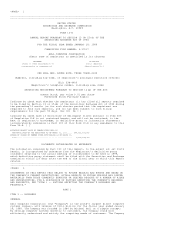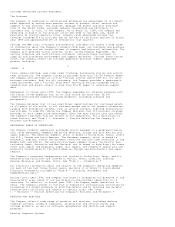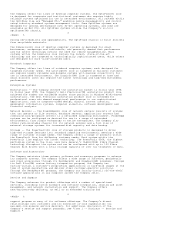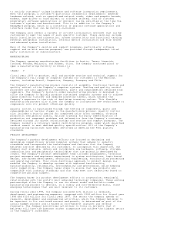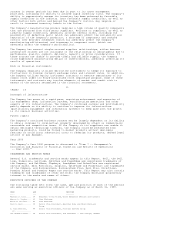Dell 1998 Annual Report Download - page 9
Download and view the complete annual report
Please find page 9 of the 1998 Dell annual report below. You can navigate through the pages in the report by either clicking on the pages listed below, or by using the keyword search tool below to find specific information within the annual report.PATENTS, TRADEMARKS AND LICENSES
The Company holds a portfolio of 437 U.S. patents and 327 U.S. patent
applications pending, and has a number of related foreign patents and patent
applications pending. The Company's U.S. patents expire in years 2005 through
2015. The inventions claimed in those patents and patent applications cover
aspects of the Company's current and possible future computer system prod-
8
<PAGE> 10
ucts, manufacturing processes and related technologies. The Company is
developing a portfolio of patents that it anticipates will be of value in
negotiating intellectual property rights with others in the industry.
The Company has obtained U.S. federal trademark registration for its DELL word
mark and its Dell logo mark. The Company owns registrations for 25 of its other
marks in the U.S. As of March 1, 1999, the Company had pending applications for
registration of 23 other trademarks. The DELL word mark, Dell logo and other
trademark and service mark registrations in the U.S. may be renewed as long as
the mark continues to be used in interstate commerce. The Company believes that
establishment of the DELL mark and logo in the U.S. is material to the Company's
operations. The Company has also applied for or obtained registration of the
DELL mark and several other marks in approximately 190 other countries or
jurisdictions where the Company conducts or anticipates expanding its
international business. The Company has also taken steps to reserve corporate
names and to form non-operating subsidiaries in certain foreign countries where
the Company anticipates expanding its international business.
The Company has entered into a variety of licensing and cross-licensing
agreements pursuant to which the Company licenses various patented hardware
technology. In addition, the Company has entered into non-exclusive licensing
agreements with Microsoft Corporation for various operating system and
application software. The Company has also entered into various software
licensing agreements with other companies.
From time to time, other companies and individuals assert exclusive patent,
copyright, trademark or other intellectual property rights to technologies or
marks that are important to the computer industry or the Company's business. The
Company evaluates each claim relating to its products and, if appropriate, seeks
a license to use the protected technology. The licensing agreements generally do
not require the licensor to assist the Company in duplicating its patented
technology nor do these agreements protect the Company from trade secret,
copyright or other violations by the Company or its suppliers in developing or
selling these products.
INFRASTRUCTURE
Management Information Systems
The Company's management information systems enable the Company to track each
unit sold from the initial sales contact, through the manufacturing process to
post-sale service and support. The systems assist the Company in tracking key
information about its customers. Using its database to assess purchasing trends,
advertising effectiveness and customer and product groupings, the Company
targets marketing activities specifically to particular types of customers. This
database, unique to the Company's direct model, allows the Company to gauge
customer satisfaction issues and also provides the opportunity to test new
propositions in the marketplace prior to product or service introductions.
Employees
At January 29, 1999, the Company had approximately 24,400 employees.
Approximately 16,100 of those employees were located in the U.S., and
approximately 8,300 were located in other countries. The Company has never
experienced a work stoppage due to labor difficulties and believes that its
employee relations are good.
GOVERNMENT REGULATION
The Company's business is subject to regulation by various federal and state
governmental agencies. Such regulation includes the radio frequency emission
regulatory activities of the U.S. Federal Communications Commission, the
anti-trust regulatory activities of the U.S. Federal Trade Commission and
Department of Justice, the import/export regulatory activities of the
9
<PAGE> 11
U.S. Department of Commerce and the product safety regulatory activities of the
U.S. Consumer Products Safety Commission.
The Company also is required to obtain regulatory approvals in other countries
prior to the sale or shipment of products. In certain jurisdictions, such
requirements are more stringent than in the U.S. Many developing nations are
just beginning to establish safety, environmental and other regulatory
requirements, which may vary greatly from U.S. requirements.


